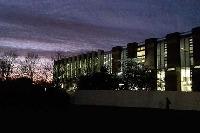Blog
Unless otherwise stated, content is shared under CC-BY-NC Licence
Doing Digital Preservation
Adam Harwood is Research Data and Digital Preservation Technologist at the University of Sussex
For two and a half years we have been talking about doing digital preservation here in Special Collections at the University of Sussex. We've also been convincing various people that we should be doing digital preservation. We've been holding meetings, giving presentations, obtaining resources, evaluating products, reading blogs, figuring out integrations, working through possible workflows, attending conferences and workshops, collaborating with researchers and trying to figure out a forensics process. And learning - we've been doing a hell of a lot of learning. Two and a half years of being a digital preservation professional and I've not done a single bit of any actual digital preservation. Sure, I've played with a few pieces of software, calculated checksums, generated METS files and BagIt folders, but only in the name of learning.
Taking Stock after 15 years Panel at iPres 2018
Colin Armstrong is a Disc Imaging Technician at the British Library and attended iPRES 2018 with support from the DPC's Leadership Programme which is generously funded by DPC Supporters
One of the later sessions I attended at iPRES 2018 was the ‘Taking Stock after 15 years at iPres 2018’ panel session. The speakers on the Panel were Barbara Sierman (Digital Preservation Manager in the Research Department at the National Library of the Netherlands), Sheila Morrissey (Senior Researcher at Portico), and Maureen Pennock (Head of Digital Preservation at the British Library), with the general theme being what has worked and what hasn’t worked in the preservation of digital artefacts, and what to expect in the coming years.
Learning from our past: Recent digital preservation initiatives at LAC
Faye Lemay is Digital Preservation Manager at Library and Archives Canada
This is part 2 of a 4-part series on Digital Preservation at Library and Archives Canada. Part 1 is posted here: https://www.dpconline.org/blog/building-momentum-for-change
In part 2 of this series, we describe the recent initiatives at LAC leading up to the creation of the Strategy for a Digital Preservation Program.
In the early 2010’s, the Digital Preservation business unit was a fledgling team. There were multiple internal and external pressures on LAC to beef up its digital preservation capacity, such as an accelerating volume of digital materials that needed to be preserved for the long-term. In 2014, the Auditor General of Canada had issued a report raising questions about the readiness of LAC to handle digital records as the format of choice by 2017. It stated that LAC “must articulate these plans in its vision, mission and objectives. It must put in place strategies, policies and procedures that will allow the transfer and preservation of digital information so that it is accessible to current and future generations”. The audit report highlighted “the need for an electronic archival system such as a trusted digital repository to acquire, preserve and facilitate access to the digital collection”.
Web Preservation at iPRES 2018
Colin Armstrong is a Disc Imaging Technician at the British Library and attended iPRES 2018 with support from the DPC's Leadership Programme which is generously funded by DPC Supporters
It is important to state fae the off that web preservation and internet archiving is not something I am particularly familiar with; so I was pleased to attend the morning paper presentations on web preservation and get tae grips with the terminology, learn about some practical theories in identifying and measuring web page similarity, understand how different web archive collections are created, and learn about some of the tools used to detect when collections go off-topic.
Researching malware at the British Library
I have recently travelled from Melbourne, Australia to work on a three-month research project with the Digital Preservation Team at the British Library. This project will explore the role of virus checking in long-term collection management and digital preservation.
Computer viruses are a form of malware—an umbrella term which refers to various types of ‘malicious software,’ including viruses, spyware, ransomware, worms and Trojan horses (Symantec Corporation n.d.). Viruses are programs that can be disruptive and destructive to computer environments by displaying unwanted messages, deleting files or removing the BIOS (basic input/output system) so that the computer can no longer start up.
A valediction for validation?
This blog post is an expansion and update of a reply I made to the digipres listerv in response to a query from Bernadette Houghton. It's also part of a response I began making at the Apres iPRES unconference to colleagues who were concerned I wasn't being disruptive enough at this year's iPRES (bless you all). The spirit of this blog post is for them.
This is what Bernadette asked:
"I’m currently doing some research into file format validators (e.g. http://description.fcla.edu/) and during my testing noted that anomalies are very common; at least, for those random files I’ve been checking.
In the real digital preservation world, what’s the best practice in regard to files with anomalies detected? Are the files preserved as they are, or are they resaved (either into the same or a different format) to get rid of the anomalies?
Of course, it may be that the anomalies are a result of a bug in the validator rather than the files themselves. But that isn’t always going to be apparent."
This is an issue many will be familiar with. Applying validation and attempting to make it work for us is not straightforward. In fact, it seems so far from working for us that I'd like to step back a little and consider whether validation is meeting our digital preservation needs, and if there's another direction we could take?
Preserving practice research: on beyond A.B.C.
This post was a collaborative effort between members of the University of Kent Templeman Library: Helen Cooper, Elspeth Millar, Katie Edwards, Rosalyn Bass, Clair Waller and Josie Caplehorne
The University of Kent was founded in 1965 as a new kind of interdisciplinary institution, a ‘community of scholars’. It was based on a collegiate system that actively encouraged both students and staff to go beyond narrow disciplinary boundaries. There were no set departments, and students undertook a compulsory year of ‘interdisciplinary studies’ at the beginning of their undergraduate degrees. It has since taken on a more traditional structure but endeavours to remain true to these values.
The Archives and Records Management Quality Improvement Framework - not just another boring tick box exercise
The Archives and Records Management Services Quality Improvement Framework (ARMS). It’s not exactly a catchy title, is it? Quality improvement frameworks don’t usually inspire curiosity, never mind excitement. If you have come across ARMS or other QI frameworks, you might be thinking this looks like a lot of work, I already know what our strengths and weaknesses are - what are the benefits? There are quite a few:
- Raising your profile
- Supporting you in achieving the archive accreditation standard
- Implementation of the Public Records (Scotland) Act, 2011 and other legislation
- Overcoming challenges, addressing your priorities
- Working more efficiently
- Evidencing your value – to funders and a range of stakeholders
If you’re working in an archive or records management context, pushed for time and sceptical about self-evaluation and improvement frameworks, please read on. I can’t promise you’ll end up being a convert but hopefully you’ll be clearer on the benefits (and maybe even a little excited).
What ARMS is and what it isn’t…
Email is the correspondence of the future (and the present?)
Dave Heelas is the Archivist and Records Manager for Unilever Art, Archives & Records Management
The last challenge we have encountered that I am going to focus on with these short blogs is the question of email. So far not a lot of email content, either individual messages or full accounts have made it to the archive. But with those that have a few questions in how we handle this in the future have arisen.
Although we have workflows in place to preserve email and can be confident that at least in the immediate future this is protected. How to deal with the sheer quantity of it all however is another issue entirely. Current preservation of email has been done in one off ingests with individual emails being sent directly to the archivist dealing with the collection. In the future how we approach this will clearly need to change, the potential of scale for emails that won’t be relevant to our collecting policy will present quite an issue. Gone are the days of the correspondence file, now the majority of people have all their emails in their inbox and outbox and rely on prior knowledge and search tools in order to find older discussions.
Back up or back away
Richard Higgins works in Durham University Library's Archives and Special Collections, where he has worked on developing cataloguing, repository and discovery systems
My suspicion of the backup dates back to the first job where I used a computer as more than an entry terminal and developed a deeper involvement in its business use.
















































































































































